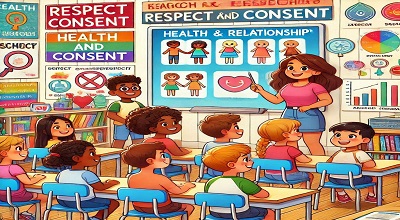Sex Education
Sex education is a comprehensive and age-appropriate program or curriculum that provides individuals with information, knowledge, and skills related to human sexuality, sexual health, and relationships. The primary goal of SE is to empower individuals to make informed and responsible decisions about their sexual and reproductive health.
Sex education typically covers a wide range of topics, including:
- Anatomy and physiology: Teaching about the male and female reproductive systems, sexual organs, and how they function.
- Reproduction: Explaining the process of fertilization, pregnancy, childbirth, and contraception methods.
- Sexual health: Discuss topics such as sexually transmitted infections (STIs), HIV/AIDS, and how to protect oneself from these infections.
- Relationships: Providing guidance on healthy relationships, consent, communication, and emotional aspects of sexuality.
- Puberty: Explaining the physical and emotional changes that occur during puberty.
- Gender and sexual orientation: Addressing issues related to gender identity, sexual orientation, and diversity in sexuality.
- Birth control: Informing individuals about various methods of contraception and their effectiveness.
- Safe sex: Promoting safe sexual practices, including the use of condoms and regular STI testing.
- Sexual ethics and values: Discussing personal and cultural beliefs about sexuality, ethics, and values.
Summary
Sex education programs can vary widely in scope and content, depending on cultural, religious, and regional factors. They may be taught in schools, by healthcare professionals, or in community settings. The approach to sex education may also differ, with some programs emphasizing abstinence-only education, while others focus on comprehensive SE. Which includes information about both abstinence and safe sex practices.
The aim of sex education is to equip individuals with the knowledge and skills they need to make responsible decisions about their sexual health, engage in healthy relationships, and navigate the complexities of human sexuality while minimizing the risks associated with sexual activity. Effective sex education programs are evidence-based, non-judgmental, and age-appropriate, considering the developmental stage and needs of the learners.
Examples of Sex Education
Sex education programs and initiatives can take various forms, depending on the target audience, cultural context, and educational goals. Here are some examples of SE:
School-Based Sex Education:
Comprehensive Sexuality Education (CSE): This approach provides students with age-appropriate, evidence-based information on a wide range of topics related to sexuality, including anatomy, reproduction, relationships, contraception, and sexual health. It often promotes abstinence as an option while also emphasizing the importance of safe sex.
Abstinence-Only Education:
Some programs focus primarily on promoting abstinence from sexual activity until marriage. These programs may provide limited information about contraception and safe sex.
LGBTQ+ Inclusive Education:
Sex education programs that are LGBTQ+ inclusive aim to provide information and support to LGBTQ+ students, addressing their unique needs and challenges related to sexual health and relationships.
Community-Based SE:
Workshops and Classes:
Community organizations, healthcare providers, and non-profits often offer workshops and classes on various aspects of SE, including STI prevention, contraception, and healthy relationships.
Parenting Programs:
Some sex education initiatives target parents and caregivers, providing them with resources and guidance on how to talk to their children about sex and relationships.
Online Resources:
Websites and Apps: There are numerous websites and mobile apps that offer information and resources related to SE. These platforms can provide access to articles, videos, and interactive tools on topics like contraception, sexual health, and consent.
Healthcare Provider Guidance:
Healthcare professionals play a crucial role in providing sex education and counseling to patients. They may offer information on contraception methods, STI testing, and sexual health during routine medical visits.
Peer Education:
Peer-led programs involve trained young people educating their peers about sexual health and relationships. Peer educators can create a safe and relatable space for discussions.
Public Health Campaigns:
Public health campaigns often focus on specific issues, such as condom use, HIV prevention, or raising awareness about STIs. These campaigns may include advertisements, social media initiatives, and community outreach.
Sex Education in Correctional Facilities:
In some cases, SE is provided to individuals in correctional facilities to promote safe and responsible behavior and reduce the risk of STIs and unintended pregnancies.
It’s important to note that the effectiveness of Sex Education programs can vary depending on factors such as comprehensiveness, quality, and cultural sensitivity. Evidence-based and inclusive approaches that respect diverse perspectives and identities tend to be more successful in achieving their goals of promoting sexual health and well-being.
